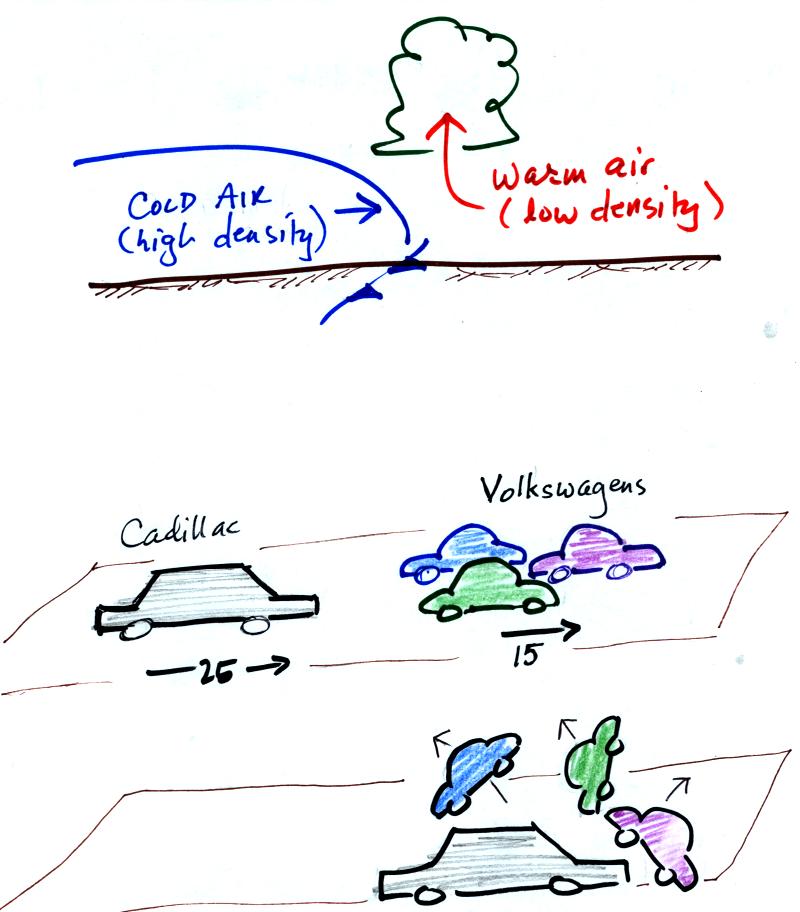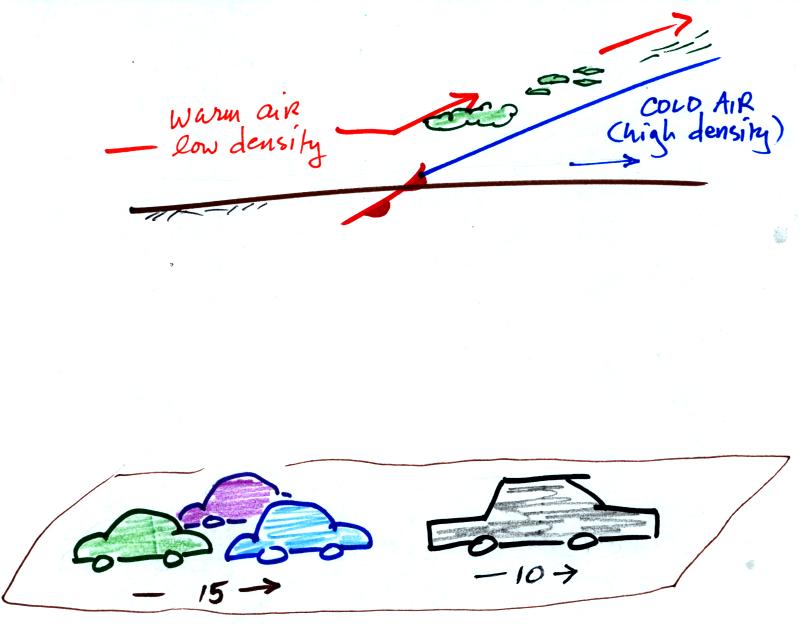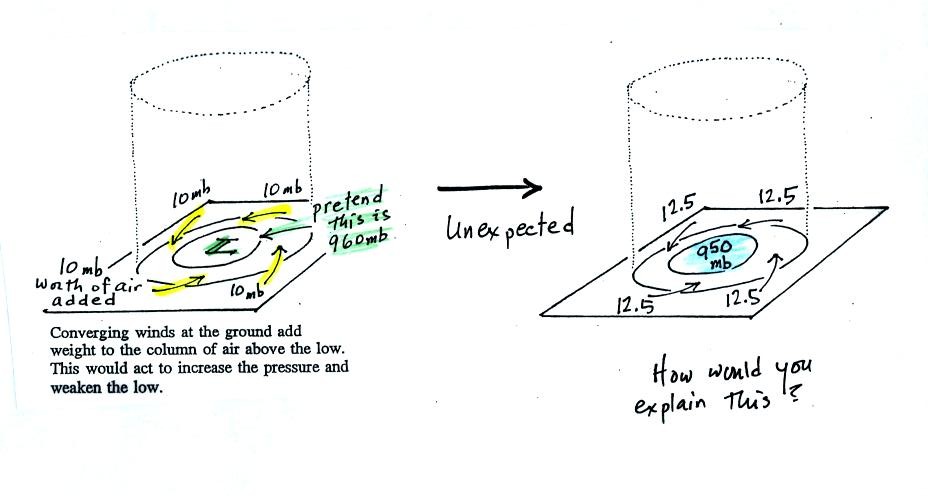
Winds spin clockwise
and spiral outward, diverge, from high pressure. Sinking air in
the center of the high replaces the outward moving air. Sinking
air warms and prevents clouds from forming.
And here is where we left off in
class on Wednesday.

The figure shows the cold front and
warm front boundaries that form when air masses with different
temperatures and moisture contents collide. Fronts are a 2nd way
of
causing air to rise (we'll see why this occurs shortly). The
storm system above is called a middle latitude storm or an
extratropical cyclone (a hurricane is a tropical cyclone).
The top picture below shows a crossectional view of a cold front
The top picture below shows a crossectional view of a cold front

At the top of the figure, cold
dense air on the left is
advancing into
warmer lower density air
on the right. We are looking at the front edge of the cold air
mass, note the blunt shape. The warm low density air is lifted
out of the way
by the cold air.
The lower figure shows an analogous situation, a big heavy Cadillac plowing into a bunch of Volkswagens. The VWs are thrown up into the air by the Cadillac.
A couple of video tapes were shown at this point. One attempted to show, using mixtures of water and glycerin colored red and blue, cold dense air displacing warm lower density air like you might see along a cold front. The second was a time lapse video of an actual cold front passing through Tucson on Easter Sunday, 1999. Clouds forming along the front edge of the front made the front visible.
Here's a crossectional view of a warm front, the structure is a little different.
The lower figure shows an analogous situation, a big heavy Cadillac plowing into a bunch of Volkswagens. The VWs are thrown up into the air by the Cadillac.
A couple of video tapes were shown at this point. One attempted to show, using mixtures of water and glycerin colored red and blue, cold dense air displacing warm lower density air like you might see along a cold front. The second was a time lapse video of an actual cold front passing through Tucson on Easter Sunday, 1999. Clouds forming along the front edge of the front made the front visible.
Here's a crossectional view of a warm front, the structure is a little different.

In the case of a warm
front we are looking
at
the
back,
trailing edge of cold air (moving slowly to the right). Note the
ramp
like shape of the cold air mass. Warm air overtakes the cold
air. The warm air is still less dense than the cold air, it can't
wedge its way underneath the cold air. Rather the warm air
overruns the cold air. The warm air rises again (more gradually)
and clouds form. The clouds generally are spread out over a
larger area than with cold fronts.
In the automobile analogy, the VWs are catching a Cadillac. What happens when they overtake the Cadillac?
In the automobile analogy, the VWs are catching a Cadillac. What happens when they overtake the Cadillac?

The Volkswagens
aren't heavy
enough to lift the
Cadillac.
They run up and over the Cadillac.
Fronts are another way of causing air to rise. Rising air cools and if the warm air is moist, clouds and precipitation can form.
We will come back to the topic of front next Monday. We will, in particular, learn about some of the weather changes that take place as a front approaches and passes through. We will also look at how fronts can be located on surface weather maps.
Fronts are another way of causing air to rise. Rising air cools and if the warm air is moist, clouds and precipitation can form.
We will come back to the topic of front next Monday. We will, in particular, learn about some of the weather changes that take place as a front approaches and passes through. We will also look at how fronts can be located on surface weather maps.
Now we will take a little time and
learn about upper level weather maps. There are charts the depict
conditions at some level above the ground. Upper level conditions
can affect what is happening at the ground (and vice versa).
We started with three basic things to know about upper level charts. First the overall appearance is somewhat different from a surface weather map. On a surface map you generally find circular (more or less) centers of high and low pressure. You can also find closed high and low pressure centers at upper levels, but more generally you find a wavy pattern like sketched below (the figures below are from a previous class and were used because they are a little clearer than the figures shown in class).
We started with three basic things to know about upper level charts. First the overall appearance is somewhat different from a surface weather map. On a surface map you generally find circular (more or less) centers of high and low pressure. You can also find closed high and low pressure centers at upper levels, but more generally you find a wavy pattern like sketched below (the figures below are from a previous class and were used because they are a little clearer than the figures shown in class).

The u-shaped
portion of the pattern is
called a
trough. The
n-shaped portion is called a ridge.

Troughs are produced by large
volumes of cool or cold air (the
cold air
is found between the ground and the upper level that the map
depicts). The
western half of the country in the map above would probably be
experiencing colder than average temperatures. Large volumes of
warm or hot air produce ridges.

The winds on upper level charts
blow parallel to the contour
lines. On a surface map the winds cross the isobars slightly,
spiralling into centers of low pressure and outward away from centers
of high pressure. The winds generally blow from west to east.
Next we will look at some of the interactions between features on surface and upper level charts
Next we will look at some of the interactions between features on surface and upper level charts

On the surface map you see centers
of HIGH and LOW
pressure.
The low pressure center, together with the cold and warm fronts, is a
middle latitude storm.
Note how the counterclockwise winds spinning around the LOW move warm air northward (behind the warm front on the eastern side of the LOW) and cold air southward (behind the cold front on the western side of the LOW). Clockwise winds spinning around the HIGH also move warm and cold air. The winds are shown with thin brown arrows on the surface map.
Note the ridge and trough features on the upper level chart. We learned that warm air is found below an upper level ridge. Now you can begin to see where this warm air comes from. Warm air is found west of the HIGH and to the east of the LOW. This is where the two ridges on the upper level chart are also found. You expect to find cold air below an upper level trough. This cold air is being moved into the middle of the US by the northerly winds that are found between the HIGH and the LOW.
Note the yellow X marked on the upper level chart directly above the surface LOW. This is a good location for a surface LOW to form or develop and strengthen (in a strengthening storm the surface low pressure in the center of the storm will get even lower than it is now) We will find that this is frequently a location where there is upper level divergence. Similary the pink X is where you often find upper level convergence. This could cause surface high pressure to get even higher.
Note how the counterclockwise winds spinning around the LOW move warm air northward (behind the warm front on the eastern side of the LOW) and cold air southward (behind the cold front on the western side of the LOW). Clockwise winds spinning around the HIGH also move warm and cold air. The winds are shown with thin brown arrows on the surface map.
Note the ridge and trough features on the upper level chart. We learned that warm air is found below an upper level ridge. Now you can begin to see where this warm air comes from. Warm air is found west of the HIGH and to the east of the LOW. This is where the two ridges on the upper level chart are also found. You expect to find cold air below an upper level trough. This cold air is being moved into the middle of the US by the northerly winds that are found between the HIGH and the LOW.
Note the yellow X marked on the upper level chart directly above the surface LOW. This is a good location for a surface LOW to form or develop and strengthen (in a strengthening storm the surface low pressure in the center of the storm will get even lower than it is now) We will find that this is frequently a location where there is upper level divergence. Similary the pink X is where you often find upper level convergence. This could cause surface high pressure to get even higher.
Now we
need to look in a little more detail at how upper level winds can
affect the development or intensification of a surface storm.
This next section might be a little confusing, you might need to read
through it a couple of times.

The figure shows a cylinder of air
(see p. 42 in the photocopied
Classnotes). The pressure at the center at the bottom of
the cylinder is determined by the weight of the air overhead. The
surface winds are spinning counterclockwise and spiraling in
toward the center of the surface low. This adds air to the
cylinder of
air. Adding air to the cylinder means the cylinder will
weigh more and you would expect the surface pressure at the bottom of
the cylinder to increase.
We'll just make up some numbers, this might make this clearer.
We'll just make up some numbers, this might make this clearer.

You'll find this figure on p. 42a
in the Class
Notes.
At the top we will assume the
surface low has 960 mb
pressure.
Imagine that each of the surface wind arrows winds brings in enough air
to increase the pressure
at the center of the LOW by 10 mb. You would expect the pressure
at the center of the LOW to increase from 960 mb to 1000 mb.
This is just like a bank account. You have $960 in the bank and you make four $10 dollar deposits. You would expect your bank account balance to increase from $960 to $1000.
But what if the surface pressure decreased from 960 mb to 950 mb as shown in the following figure? Or in terms of the bank account, wouldn't you be surprised if, after making 4 $10 dollar deposits, the balance dropped from $960 to $950.
This is just like a bank account. You have $960 in the bank and you make four $10 dollar deposits. You would expect your bank account balance to increase from $960 to $1000.
But what if the surface pressure decreased from 960 mb to 950 mb as shown in the following figure? Or in terms of the bank account, wouldn't you be surprised if, after making 4 $10 dollar deposits, the balance dropped from $960 to $950.

The next figure shows us what could
be happening (back to p.
42 in the Class Notes).

There may be some upper level
divergence (more arrows leaving the
cylinder than going in ). Upper level divergence removes air from
the cylinder and would decrease the weight of the cylinder (and that
would lower the surface pressure)
We need to determine which of the two (converging winds at the surface or divergence at upper levels) is dominant. That will determine what happens to the surface pressure.
Again some actual numbers might help (see p. 42b in the Class Notes)
We need to determine which of the two (converging winds at the surface or divergence at upper levels) is dominant. That will determine what happens to the surface pressure.
Again some actual numbers might help (see p. 42b in the Class Notes)

The 40 millibars worth of surface
convergence is shown at Point
1. Up at Point 2 there are 50 mb of air entering the cylinder but
100 mb leaving. That is a net loss of 50 mb. At Point 3 we
see the overall result, a net loss of 10 mb. The surface pressure
should decrease from 960 mb to 950 mb. That change is reflected
in the next picture (found at the bottom of p. 42b in the Class Notes).

The surface pressure is 950
mb. This means there is more of
a
pressure difference between the low pressure in the center of the storm
and the pressure surrounding the storm. The surface storm has
intensified and the surface winds will blow faster and carry more air
into the cylinder (the surface wind arrows each now carry 12.5 mb of
air instead of 10 mb). The converging surface winds add 50 mb of
air to the cylinder (Point 1), the upper level divergence removes 50 mb
of air from the cylinder (Point 2). Convergence and divergence
are in balance (Point 3). The storm won't intensify any further.
The following figure wasn't shown
in class. I'll show it in class on Monday.

Now that you
have some idea of what upper level divergence looks like
(more air leaving than is going in) you are in a position to understand
another one of the relationships
between the surface and upper level winds.
One of the things we have learned about surface LOW pressure is that the converging surface winds create rising air motions. The figure above gives you an idea of what can happen to this rising air (it has to go somewhere). Note the upper level divergence in the figure: two arrows of air coming into the point "DIV" and three arrows of air leaving (more air going out than coming in is what makes this divergence). The rising air can, in effect, supply the extra arrow's worth of air.
Three arrows of air come into the point marked "CONV" on the upper level chart and two leave (more air coming in than going out). What happens to the extra arrow? It sinks, it is the source of the sinking air found above surface high pressure.
One of the things we have learned about surface LOW pressure is that the converging surface winds create rising air motions. The figure above gives you an idea of what can happen to this rising air (it has to go somewhere). Note the upper level divergence in the figure: two arrows of air coming into the point "DIV" and three arrows of air leaving (more air going out than coming in is what makes this divergence). The rising air can, in effect, supply the extra arrow's worth of air.
Three arrows of air come into the point marked "CONV" on the upper level chart and two leave (more air coming in than going out). What happens to the extra arrow? It sinks, it is the source of the sinking air found above surface high pressure.